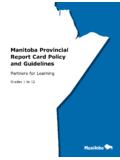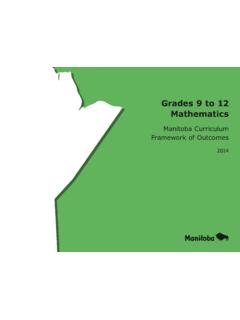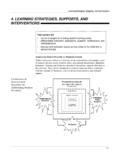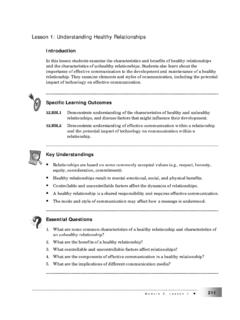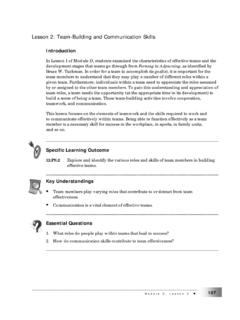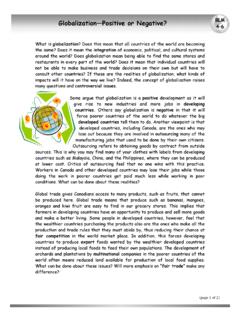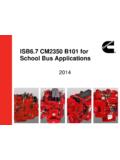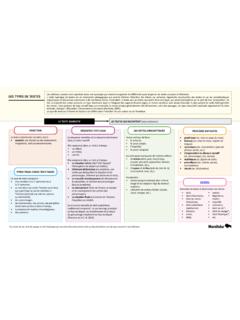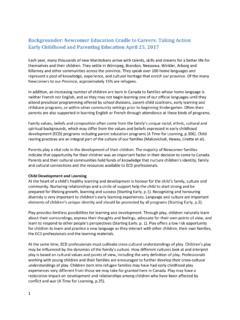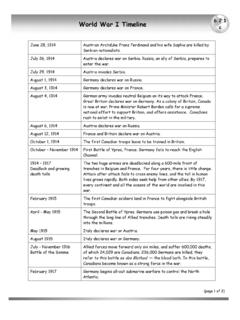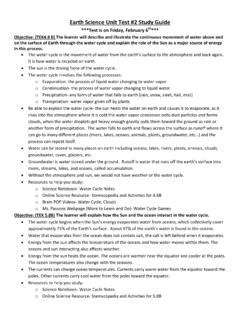Transcription of Grade 2 C1 - Manitoba
1 Grade 2 ScienceManitoba Education and Training1999 Grade 2 Cluster 1:Growth andChanges in AnimalsOverviewIn Grade 2, students focus on animals to build upon theirknowledge of living things (see Grade 1, Cluster 1: Characteristicsand Needs of Living Things). All animals grow and change frombirth until adulthood. Because children are interested in thechanges that take place over the lifetime of different animals,observing these changes becomes a powerful learning experiencefor them. In their explorations of growth, students compare theirown growth with the growth patterns of various animals, andthey learn about the conditions needed to support healthydevelopment. Particular attention is given to the nutritionalrequirements of to Grade 4 Science: A Foundation for Introduce, explain, and reinforce vocabulary throughout the cluster. Word Wall Develop a classroom list of science words as the unit of studyprogresses. Record the words on cards and post on a ScienceWord Wall (Cunningham, 1991).
2 Post the list where it is easilyvisible and encourage students to refer to it during journal orother writing. Comparing MyselfHave students bring photos of themselves as an infant, a toddler,and as a six- or seven-year-old. Have students work in pairs tocomplete the following chart. Post charts and have studentspresent their information to the students look at the baby pictures of their classmates. Askstudents the following questions: How are all the babies the same? How have all the babies changed?Picture Match: Put the baby pictures on the bulletin board andask students to try and match each picture to a student in theclassroom. Discuss how easy or difficult they found this Height ComparisonHave students work in pairs to measure the height of theirpartner and then record their information on self-stick the self-stick notes on a pre-constructed class students these questions: Why do you think that students of the same age are not the same height?
3 (food, family characteristics) At what age do you think we stop growing?Have students measure, record, and graph the heights of a classof students in a higher I Have ChangedSameDifferentblue eyes tallerbrown hair longer/more hairSUGGESTIONSFORINSTRUCTIONS tudents appropriate vocabularyrelated to their investigations ofgrowth and changes in : food groups, Canada s FoodGuide to Healthy Eating, offspring,adult, behaviour, life cycle, stage, lifeprocesses, as well as terms relating tolife cycles : B3, C6, D12-1-02 Identify and describe constantand changing characteristics ofhumans as they grow and : eye colour remainsconstant, height : D1, E32-1-03 Recognize that all humans donot grow and develop at the : B3, D1, E1, E32-0-1b. Make predictions based on observedpatterns or on collected data. (ELA , )GLO: A1, C22-0-5b. Use, with guidance, tools to observe,measure, and construct. Examples: ruler, metrestick, pan balance, magnifying glass, bathroomscale, (Math ) GLO:C2, C3, C52-0-5d.
4 Estimate and measure length usingstandard units. (Math ) GLO: C2, C3, C52-0-6a. Construct and label concrete-objectgraphs, pictographs, and bar graphs using 1:1correspondence. (Math ) GLO: C2, C62-0-6b. Discuss data and generate newquestions from displayed data. (Math SP )GLO: A1, A2, C2, C5(continued) 2, Cluster 1: Growth and Changes in AnimalsTeachers may want to have a set ofclassroom photos ready in order tofacilitate student comparisons ofcontemporary and baby to Grade 4 Science: A Foundation for that food is a formof energy and that healthy eating isessential for growth : B3, D1, D4, E4 Ask the following questions: What do you notice about the data collected? How is this graph the same as our class height graph? How is this graph different from our class height graph? If we measured the heights of a class of high school students what do you think the graph would show? Explain your thinking. Energy AnalogyGive the students this analogy:Gas is to car as food is to _____.
5 (animal)Ask students the following questions for reflection: What word do you think belongs in the blank? Why? Why does a car need gas? Why do animals need food? (to provide energy) Healthy BodiesHave students think about what their bodies need to stay healthyand grow and have them share their ideas with a partner. Discussthe findings with the whole class. Food SortProvide students with pictures of a variety of foods representingthe four food groups. Have them work in small groups to sortthe pictures using their own classification system. Share theirsorts with the class. Develop with the students a food grouplabel for each sort. Clarify any misconceptions regarding foodgroup placements at this time. Canada s Food GuideDistribute a copy of Canada s Food Guide to Healthy Eatingtostudents. Ask these questions: What information is included in the Food Guide? How does this information help you decide what to eat each day? Why is important to eat something from each food group each day?
6 Where do things like potato chips, cake, and candy fit on the Food Guide?(continued)2-1-05 Identify the four food groupsof Canada s Food Guide to HealthyEatingand give examples of foodsfrom each : B3, E12-0-4g. Verbalize questions, ideas, andintentions during classroom activities. GLO: C62-0-6c. Place materials and objects in asequence or in groups using one or twoattributes, and describe the system used. ( ) GLO: C2, C3, C52-0-4f. Work in a variety of cooperativepartnerships and groups. (ELA ) GLO: and Pencil Task: Food SortStudent Directions: Provide pictures of food, labels from food, etc.,for students. Have students sort the pictures into the correct foodgroups, using a chart like the one & Vegetables Breads & CerealsPoultry, Meat, Fish, & DairyMeat SubstitutesOtherTEACHERNOTESSUGGESTIONSF ORASSESSMENTG rade 2, Cluster 1: Growth and Changes in AnimalsCanada s Food Guide to HealthyEating is distributed by HealthCanada telephone (204) 983-2508, or(613) 954-5995.
7 It is also availableonline at < >.Kindergarten to Grade 4 Science: A Foundation for Meal PlanningUse food pictures from the sorting activity, magazines, orstudent drawings. Have the students illustrate a nutritionallybalanced breakfast, lunch, and supper. Display each meal on a paper plate. Ask students to explain why their meals arebalanced. Fact Talk About FoodHave students give a short talk about good nutrition and the fourfood groups from Canada s Food Guide for Healthy opportunities for students to practise their talks withparents and peers before the presentation. (See ELA, Grade 2, ) Math ConnectionHave students survey their classmates to find out what theirfavourite foods are and then graph the data collected. BrainstormHave students work with a partner to brainstorm a list of tenfoods for each food group. Ask students: Where does the foodyou have listed come from before it gets to the grocery store?Through the discussion, have students recognize that food comesfrom plants and animals.
8 Sort and Classify FoodsHave students sort their listed foods according to whether theycome from plants or animals. Discuss with the class any foodsthey have had difficulty in placing. Twenty QuestionsPlace one food item or a replica or picture of the food item in anopaque bag. Have students apply the information learned aboutfoods to ask questions that can be answered yes or no, and to tryand discover the identity of the hidden food. Questioningcontinues until the food has been identified or twenty questionshave been asked. The student who guesses correctly chooses thenext food that foods humanseat come from plants and animals,and classify foods : B1, B32-0-6c. Place materials and objects in asequence or in groups using one or twoattributes, and describe the system used. ( ) GLO: C2, C3, C52-0-9a. Willingly consider other people s : C5, C72-1-06 Plan a menu for one daybased on the four food groupsoutlined in Canada s Food Guide toHealthy : B3, C4, D12-0-7e.
9 Describe, in a variety of ways, what wasdone and what was observed. Examples:concrete materials, captioned drawings, (ELA , ) GLO: 2, Cluster 1: Growth and Changes in AnimalsPerformance Task: Meal PlanningScoring Rubric 4 Student s work demonstrates a solid understanding of the fourfood groups and of a balanced meal. Three balanced meals arepresented. Explanation is clear and s work demonstrates a good understanding of the fourfood groups and of a balanced meal. Three meals arepresented with two being balanced. Explanation is s work demonstrates a basic understanding of the fourfood groups and of a balanced meal. Three meals arepresented with one being balanced. Explanations may or maynot be s work demonstrates a limited understanding of thefour food groups and of a balanced meal. At least two mealsare presented. Meals shown are not balanced. Explanation isunclear or Journal Entry: Meal PlanningTell students: Pat used these ingredients to make a pizza: whole wheat pizza crust onions cheese mushrooms tomato sauce ground meat green peppersIs his pizza a healthy meal choice?
10 (Yes.) Explain your for references to the four food and Pencil Task: Sort and Classify FoodsProvide students with pictures of different types of food. Havestudents sort the foods according to whether they come fromplants or animals. See Blackline Master 10: Food Sorting Directions: Cut out each picture. Glue each picture whereit from AnimalsFood from PlantsKindergarten to Grade 4 Science: A Foundation for Matching OffspringShow the students a picture of a baby animal such as a calf,along with several different kinds of adult animals including theparents of the baby. Ask the following questions: Which adult is this animal s parent? How do you know? What s My Name?Have students work in cooperative groups to fill in the chartwith the names of the males, females, and babies of a variety group findings with the entire class. Adult-Baby Comparison Field TripIn the spring, have the class visit a local farm or zoo to observebaby animals and their parents.
